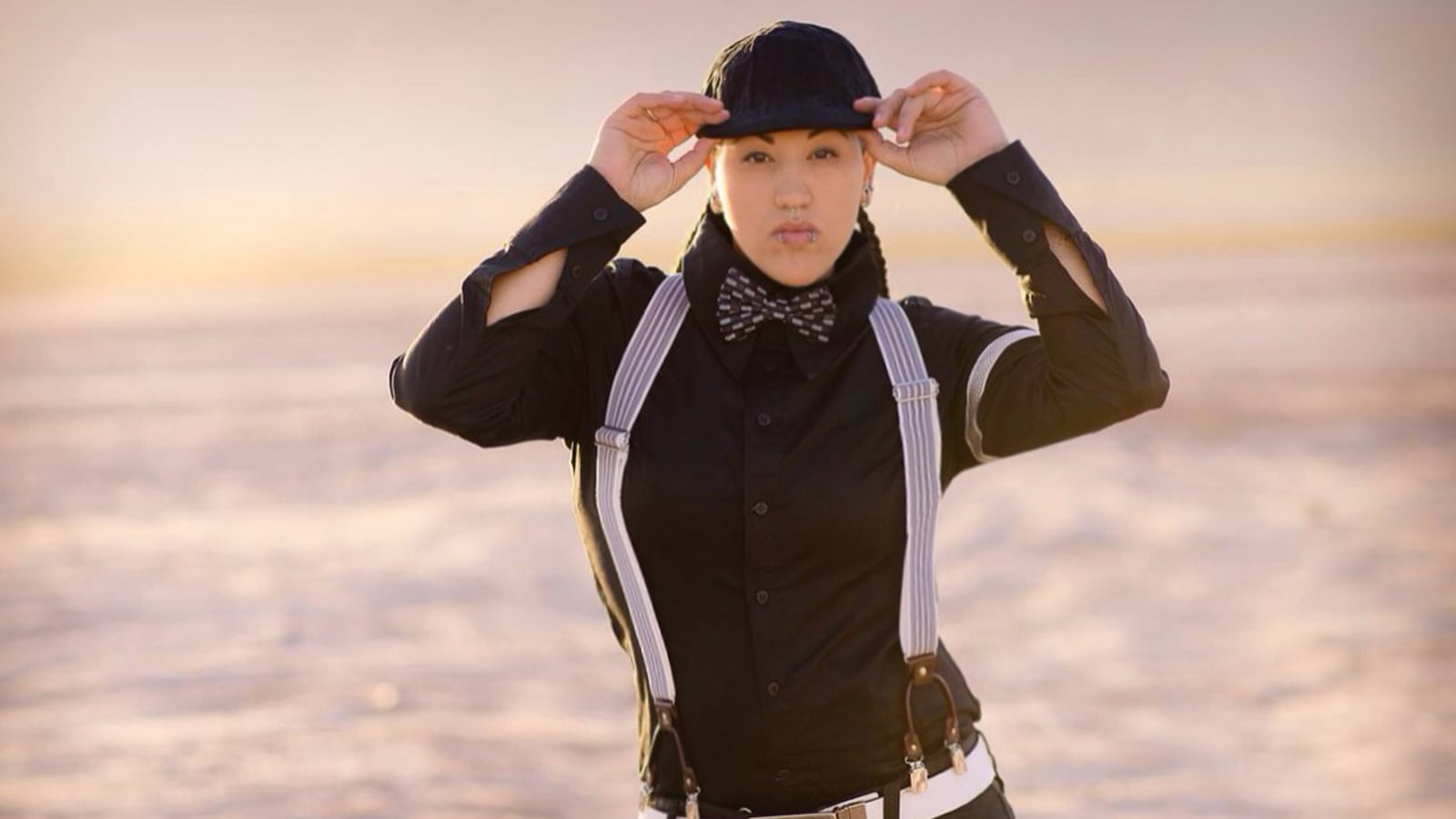The only person banned from wearing Karen Roberts’ clothing line is her wife’s ex-husband. “Go away, you have your own clothes,” she laughingly recalls telling him, as he tried to buy some pieces at an early launch. But he’s not the one intrigued by the masculine simplicity of Haute Butch, an up-and-coming Napa Valley-based fashion line for women and trans men that Roberts launched in 2012—and everyone else is welcome to try them on.
Since Chanel donned a fitted suit and hurdled to fashion eminence, women have been repurposing what was once considered menswear for their own sartorial objectives. But this demographic, who prefers to buy from the men’s section, struggles with the fit of clothes meant for a wider-shouldered and longer-limbed customer.
Enter Roberts and her budding clothing line, Haute Butch. A few years ago, Roberts’ only fashion experience was an interest in drawing and a few high school merchandising classes. Today, Women’s Wear Daily is her bible, she sits on her college’s fashion advisory committee, and is gaining international attention with a clothing line for women who prefer slacks to skirts.

Finding her style was something 52-year-old Roberts had struggled with so much that she felt it was impacting her performance at work. “I knew I was really good at what I did but what I wore really ate away at my confidence,” she says. Her job in real estate was going well, but she dreaded going into the office. Each day, she’d put on a rolled-up men’s blazer, rolled-up slacks, a rolled-up dress shirt. Everything felt unshapely compared to her female colleagues’ skirts-and-heels business casual.
“I realized I avoided or didn’t attend a lot of things throughout my life—anywhere I really had to look like a girly girl—I didn’t go,” Roberts remembers. “That’s why I always chose entrepreneur routes, too, because then I could dress how I wanted to.”
So she started sketching.
She drew inspiration from the women and men she’d met in the Bay Area’s LGBTQ scene; from designers like Carolina Herrera, in her signature crisp white dress shirt, and the sporty street style of Rick Owens; from the jacket lapels and top hats worn by ‘20s film queen Marlene Dietrich.
Soon Roberts had fleshed out plans for a men’s line for a woman’s body, including sport shirts, outerwear and skinny ties.
“The community was really pulling at me, saying, ‘Come on we need this. Someone’s got to do it,’” she remembers. As her ideas took shape, she had letters pouring in from the world over—Australia, the UK, Africa—wondering where they could find clothes of a better fit.
“And before I knew it, I wasn’t doing real estate anymore,” she says.
With a $20,000 loan from a friend, matched from her own funds and credit, Roberts got a full line up and running in early 2013.
First and most importantly there were dress shirts to be made and then the vests: two items many women like to pluck from the men’s section but are sabotaged by the lack of room for bust or hips. More items came in time, as funding was available, like a slit-and-lace-up jacket and a line of boxer underwear.

“I just think we were invisible for so long, and it’s still people fighting to come out and people fighting to look and act the way they want if they’re not gender specific and not hetero-normative,” says Stasha Wyskiel, a risk manager at a tech company called Salesforce in the Bay Area who identifies as more androgynous than butch. “[Haute Butch] is stepping into that area with such confidence and they are so non-apologetic.”
At a fashion show Haute Butch participated in a few months ago, Wyskiel snatched up a jacket and handful of dress shirts and has been getting compliments thrown at her since for the sharp lines and well-tailored fit. She’s already preparing to clean out some of her closet to make space for the brand’s upcoming line.
Style, she points out, has often come hand-in-hand with equality. “As soon as women started wearing trousers what changes happened then? What freedom did it give?” Wyskiel says, referencing an adoption of pants when women started working male jobs in World War I. “Fashion always has social commentary thrown in. What we’re seeing is a community that has not had something to call their own, and that’s the void this seems to be filling.”
Now, Roberts and her small team are gearing up to launch their next full production line since the first one came out last year. They’ve started a Kickstarter to help fund the ambitious line of dress shirts, jackets, and underwear that will be unveiled early next spring. There’s a twill-faux suede biker-style jacket, paisley suspenders, and two-tone hi-tops. She calls the designs, which are subtle and classic, as appealing as much to someone whose style is “soft butch,” to a customer shopping for “heavy menswear.”
Haute Butch is one of a number of new design houses targeting the trans, butch, and androgynous dressers. A simultaneous Kickstarter is seeking $60,000 for Sharpe Suiting, which says it uses “andropometics” to find a better fit of clothing for androgynous customers. There are many others getting their footing, like Androgyny and Original Tomboy, all manly duds for anyone.
“I don’t have any interest in keeping the separatism going,” Roberts says of the way men and women’s clothing is divided. She recalls a guy coming to her event and purchasing a bow tie, jokingly asking, “Does this mean now that I’m a lesbian?” Roberts wasn’t offended—quite the opposite.
“That means it’s working, it’s educating people. He believes in what we’re doing he wants to be a part of it because he realizes how important it is…and he’s as straight as he can be.” The only man not allowed to wear her designs, she notes, is her wife’s ex—though she finally caved and allowed him to purchase one of the hats.
In a “Men’s Section” and “Women’s Section” kind of world, there’s not much physical space allotted for what lies between, yet. Roberts would love to see the clothes in a brick-and-mortar shop, but, despite interest from a number of retailers last year, no one seem to know where to put Haute Butch.
“My gut says they don’t know how to hang us yet…that has to be defined first so we can be mainstream.” Ideally, she envisions a unisex section where “nobody’s watching who’s going there, [and asking,] Do you belong? What dressing room are you going to use? What lines are you crossing?”
Right now, Roberts still opens a closet and finds herself with only one of her own designs to wear. But it’s no longer because there isn’t clothing that fits well, but because Haute Butch’s products keep selling out and, for now, she’s been sacrificing her own style for the customers. “My hope is to have a closet that only has the type of clothes I like in it—that fit me and are that blend between masculine and feminine—and the rest of the stuff can go,” she says.






